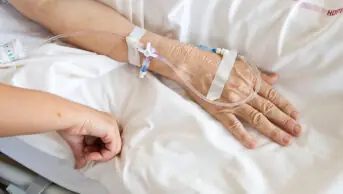Community pharmacists have frequent contact with patients with cancer and have a wider role to play than simply drug supply, said Hilary Edmonson, pharmacist, East Riding Pharmacy Development Group.
Patients with terminal illnesses want to stay at home and, in order to do so, need a well co-ordinated care team. “Pharmacist input is often missing from these teams,” she said.
Mrs Edmonson described a project assessing the pharmacist’s role in palliative care teams. A total of 14 community pharmacists participated in the project in teams with general practitioners, district and Macmillan nurses. Pharmacists had access to patients’ medical records, patients registered with one pharmacy and pharmacists recorded all interventions they made.
Debbie Needham, pharmacist, Yorkshire Coast and Wolds Primary Care Trust, explained that issues identified by the project included the fact that GPs were confused about pain management, most GPs had problems in gaining timely access to drugs, and that all health professionals requested further training about symptom control and talking to dying patients.
“Initially, pharmacists felt that they were not part of the teams but patients always thought they were. Perhaps it is professional groups that put barriers in place,” she said. GPs and nurses found it useful that patients registered with one pharmacy.
Once familiar with the process recording interventions, most pharmacists agreed that it was not too time-consuming. Over 400 interventions were recorded and 144 were assessed by a panel consisting of a palliative care consultant, a clinical pharmacist and a Macmillan nurse. A total of 81 per cent of interventions were considered to be likely to have had a positive impact on patients’ wellbeing.
As a result of difficulties expressed by GPs in gaining access to drugs, a palliative care drug stock pack has been developed. This is kept by pharmacies to ensure that they always have certain drugs available. The scheme has been rolled out to 20 community pharmacies with health authority reimbursement for any items that expire before they are used.
Pharmacists have carried on their involvement in palliative care teams since the project ended, Mrs Edmonson said. The project had increased pharmacists’ profiles and community pharmacists are now regularly involved in teams. In addition, a pharmacist is now involved in the strategic palliative care team at health authority level. “It is important for pharmacists to have this type of representation,” she added.
Mrs Needham described further developments in the palliative care service that are currently in trials. One such idea is an information file that has been created for all patients.
This includes details of their diagnosis, carers and drug therapy. It is kept at the base for on-call GPs. In particular, it records which drugs the patient has been prescribed, which treatments have been used in the past (and the reasons why any older treatments were stopped), and what is suggested should be tried next. This is useful when patients require drugs outside normal working hours and access to medical records is not possible, she said.
You may also be interested in

Support for pharmacies providing palliative care urged as hospices get cash injection

Patient access to 24/7 palliative care medicines is ‘insufficient’, finds House of Commons-commissioned report
